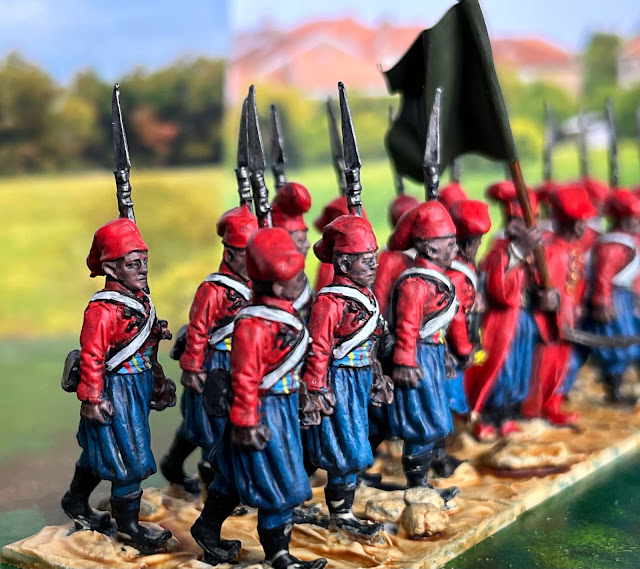Sunday's game was a First Carlist War game. The basis of the scenario was that Don Carlos was with his army in the field and had allowed his army to rest near the convent of Nuestra Señora de la Infadelidad above a sleepy village. While they rested a significant Isabellino force, supported by the British Legion and the French Foreign Legion attacked
The Carlists deployed a brigade of seven battalions and a mountain gun on the right, around the Convent, with two brigades each of two units of cavalry in support. In the village they deployed another seven battalions and a field gun while the left was held by five battalions, a field gun, two cavalry units and a mountain gun.
 |
| Don Carlos saving "Good Morning" to the troops. |
The main Isabellino force of fourteen battalions, three cavalry units, a horse gun, a field gun and a mountain gun approached from the Carlist right while the allied contingents - the French Foreign Legion of four infantry battalions, a mountain gun and a unit of cavalry, and Brutish legion of seven infantry units, a gun, two stands of rockets and unit of lancers - approached from the left.
 |
| The Carlist infantry prepare the village for defence |
The action started on the Carlist right where the cavalry were quickly engaged. One Carlist unit charged two Isabellino batteries and drove the gunners off. Two more regiments of Carlist cavalry were caught halted by two regiments of Isabellino heavy cavalry, and in the ensuing combat the Carlist managed to beat off one charge, while they were sent reeling by the second.
On the Carlist left the French were massing near the village, while the British curled around the left flank.
A unit of French cavalry boldly ride forward and a unit of Carlist cavalry matched it. Charge and counter charge followed. It was an even fight but when I rolled seven out of seven hits to the French two, the French cavalry decided that that as enough for a game of soldiers and dispersed to the wind. The Carlist troopers, unable to exploit their success, rallied back.
 |
| The French cavalry moving boldly forward |
On the extreme left the Carlist mountain gun took careful aim in the British Legion, but did only trifling damage.
Meanwhile the French Foreign Legion moved to attacked the village. A Carlist column charged out of the streets against one French Battalion starring a combat that raged for four turns, eventually destroying the French battalion, but exhausting the Carlists as well. The main French force then attacked the left of the village and initiated a long fight that eventually saw the Carlists evicted from that building.
 |
| The French commander looks anxious... |
 |
| ...while the Carlist clergy take up arms |
In front of the convent the firefight between the infantry rages on but no one is getting the upper hand.
On the Carlist extreme left the cavalry charge again and break two British Legion battalions.
But the exhausted cavalry is shot up by the remaining British. A firefight between the infantry knocks both forces about badly and in time the British decide enough is enough and break off. The French, having take one building are attacked by more Carlists pouring out of the town and after an extended fight the French are driven off.
On the Carlist right, things have not gone as well as hoped and the Isabellino forces have closed in on the Convent.
 |
| The irresistible march of the Royal Guard |
Don Carlos had by then left the convent and joined his units in the village.
The battle came to a conclusion. The Don was safe , but both armies were badly knocked around.
Many of the photos included here were provided by John L., who fought bravely in the Isabellino ranks.




















































